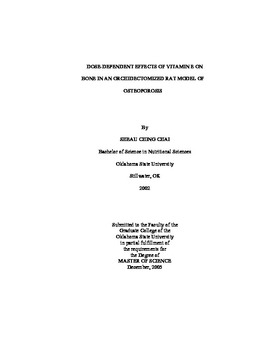| dc.contributor.advisor | Wei, Cheng-I | |
| dc.contributor.author | Chai, Sheau Ching | |
| dc.date.accessioned | 2014-04-15T22:01:00Z | |
| dc.date.available | 2014-04-15T22:01:00Z | |
| dc.date.issued | 2005-12-01 | |
| dc.identifier.uri | https://hdl.handle.net/11244/9215 | |
| dc.description.abstract | Vitamin E at a moderately high dose in the diet was shown previously to improve the biomechanical and biochemical properties of bone in old male mice. The present study was conducted to evaluate whether vitamin E can exert bone-sparing effects on osteopenic male rats using an orchidectomized rat model of osteoporasis. Forty 12-month old male Sprague-Dawley rats were either sham-operated (Sham) or orchidectomized (Orx), and fed control diet for 120 days to establish bone loss. Thereafter, rats were assigned to their corresponding treatment groups (n = 10): Sham and one Orx group received 75 IU vit E (controls), other Orx rats received 250 or 500 IU vit E per kg diet for 90 days. After 90 days of treatment, rats were necropsied and tissues were collected. Bone mineral content (BMC), and density (BMD) of whole body, 4th lumbar vertebra and right femur were measured using DXA. Bone metabolism was assessed based on biochemical markers of urinary excretion of deoxpyridiniline (Dpd) as an indicator of bone resorption, and serum osteocalcin as an indicator of bone formation. Trabecular and cortical microarchitectural properties were assessed using micro-CT. The significant losses of BMD and BMC in the whole body, right femur and 4th lumbar due to ORX were not prevented by vitamin E treatments. Neither Orx nor any of the vitamin E treatments altered serum osteocalcin level and urinary Dpd. Additionally, vitamin E supplementation has no effect in preventing Orx-induced changes of the trabecular microarchitectural parameters of distal femur. However, vitamin E supplementation provides modest bone protective effects on cortical area in femoral mid-shaft of Orx rats. Although vitamin E has been shown to have some osteoprotective properties in other animal models, so far the findings of the present study indicate that vitamin E is unable to restore bone mass once the loss has occurred in this rat model of male osteoporosis. However, vitamin E supplementation provides modest bone protective effects on the cortical area in femoral mid-shaft of Orx rats. | |
| dc.format | application/pdf | |
| dc.language | en_US | |
| dc.publisher | Oklahoma State University | |
| dc.rights | Copyright is held by the author who has granted the Oklahoma State University Library the non-exclusive right to share this material in its institutional repository. Contact Digital Library Services at lib-dls@okstate.edu or 405-744-9161 for the permission policy on the use, reproduction or distribution of this material. | |
| dc.title | Dose-dependent Effects of Vitamin E on Bone in an Orchidectomized Rat Model of Osteoporosis | |
| dc.type | text | |
| dc.contributor.committeeMember | Arjmandi, Bahram H. | |
| dc.contributor.committeeMember | Smith, Brenda J. | |
| osu.filename | Chai_okstate_0664M_1642.pdf | |
| osu.college | Human Environmental Sciences | |
| osu.accesstype | Open Access | |
| dc.description.department | Department of Nutritional Sciences | |
| dc.type.genre | Thesis | |
